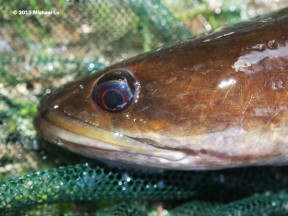Channa baramensis
Baram Snakehead
SynonymsTop ↑
Ophiocephalus baramensis Steindachner, 1901
Etymology
Channa: from the Latin channe, used to refer to an unspecified species of sea perch.
baramensis: named for the Baram River in Sarawak state, Malaysia (Borneo), type locality of this species.
Classification
Order: Perciformes Family: Channidae
Distribution
Endemic to Borneo where it’s known from throughout Sarawak state and in western parts of Sabah state, Malaysia, plus Brunei Darussalam which is surrounded by Sarawak.
Records from the Sadong drainage in eastern Sabah may refer to the congener C. melasoma.
Type locality is ‘Baram River, northern Sarawak [n. Borneo], Malaysia’.
Maximum Standard Length
180 – 220 mm.
Aquarium SizeTop ↑
An aquarium with base measuring at least 120 ∗ 45 cm is recommended.
Water depth is less important but should not be less than 30 cm.
Maintenance
Like most smaller Channa species it prefers a dimly-lit aquarium with plenty of cover in the form of live plants, driftwood branches, terracotta pipes, plant pots, etc., arranged to form a network of nooks, crannies, and shaded spots.
Surface vegetation such as Ceratopteris spp. is also appreciated and makes the fish less inclined to conceal themselves.
It’s essential to use a tightly-fitting cover since Channa spp. are notorious for their ability to escape, and a gap should be left between this and the water surface as they require access to a layer of humid air.
Diet
An obligate predator feeding mostly on smaller fishes and insects in nature but in most cases adapting well to dead alternatives in captivity.
Some specimens even accept dried foods although these should never form the staple diet.
Young fish can be offered chironomid larvae (bloodworm), small earthworms, chopped prawn and suchlike while adults will accept strips of fish flesh, whole prawns/shrimp, mussels, live river shrimp, larger earthworms, etc.
This species should not be fed mammalian or avian meat such as beef heart or chicken since some of the lipids contained in these cannot be properly metabolised by the fish and may cause excess fat deposits and even organ degeneration.
Similarly there is no benefit in the use of ‘feeder’ fish such as livebearers or small goldfish which carry with them the risk of parasite or disease introduction and at any rate tend not have a high nutritional value unless properly conditioned beforehand.
NotesTop ↑
This species was considered a synonym of Channa melasoma for a number of years prior to its revalidation by Ng. et al. (1996).
It can be distinguished by possession of a black spot in the centre of numerous body scales and a barred caudal-fin pattern (in specimens larger than 120 mm SL), characters which are missing in both C. melasoma and the similar-looking C. cyanospilos.
Members of the family Channidae are commonly referred to as ‘snakeheads’ due to possession of large scales on the head of most species which are reminiscent of the epidermal scales (cephalic plates) on the heads of snakes.
There currently exist over 30 valid species but diversity within the group is likely to prove significantly greater.
All Channa spp. possess supplementary breathing apparatus in the form of paired suprabranchial chambers located behind and above the gills, although these are not labyrinthic but lined with respiratory epithelium.
These chambers allow the fish to breathe atmospheric air and survive in hypoxic conditions or even out of the water for a considerable period of time, and in aquaria they are often seen rising to the surface to take gulps of air.
References
- Steindachner, F., 1901 - Abhandlungen der Senckenbergischen Naturforschenden Gesellschaft v. 25: 409-464
Kükenthal's Ergebnisse einer zoologischen Forschungreise in den Molukken und Borneo. Fische. - Brede, N. and P. Antler, 2009 - Natur und Tier Verlag, Münster: 62 pp.
Schlangenkopffische—Die Gattungen Channa und Parachanna. - Martin-Smith, K. M. and H. H. Tan, 1998 - The Raffles Bulletin of Zoology 46(2): 573-604
Diversity of freshwater fishes from eastern Sabah: annotated checklist for Danum Valley and a consideration of inter- and intra-catchment variability.













